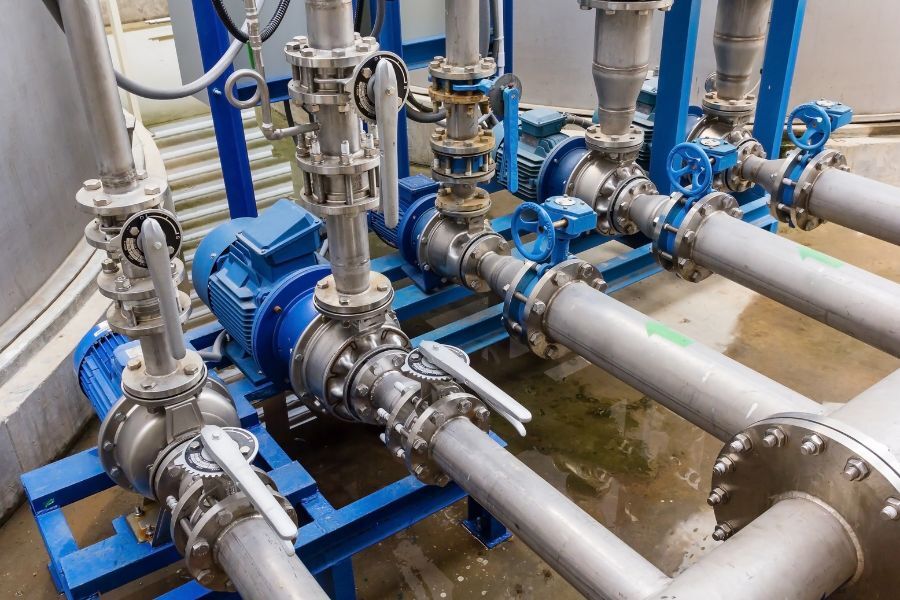
End Suction Pumps: A Closer Look at Frame-Mounted and Close-Coupled Pumps
End suction pumps are a common choice for fluid handling in a wide range of industries due to their versatility in handling both corrosive and non-corrosive fluids, the fact that they don’t need to be aligned, and their small size.
Featuring just one impeller, the suction occurs from one side of the pump casing and the fluid discharges from either the top or the other side. The pumped fluid’s velocity increases as it passes through the impeller, transforming into high pressure via diffusion before the fluid is discharged from the pump.
End suction pumps are often designed with a back pull-out and spacer coupling. This design allows maintenance without any disturbance to the motor’s alignment.
Available in several types of materials, including plastic, bronze, iron, and stainless steel, end suction pumps come with different sealing options and can be used as single stage or multi-stage configurations. They can manage most flows and pressures, ranging from tiny to moderate.
Types of end suction pumps
End suction pumps are either frame-mounted or close-coupled. Both mounting styles have different advantages and disadvantages, which need to be closely considered before choosing which mounting is best for your application.
Frame-mounted end suction pumps
Frame-mounted pumps, as the name suggests, are mounted on a common baseplate next to a driver, usually an electric motor, with flexible coupling. These pumps include an integrated bearing housing which helps extend bearing life and allow the pump to run continuously, even with high radial and thrust loads. The design of frame-mounted pumps allows for greater flexibility in terms of motor size, speed, and type (no custom motors required), and they’re available in a wide range of sizes and configurations to meet the needs of different applications.
One of the primary advantages of frame-mounted pumps is their versatility and durability. Because the pump and motor are not coupled together, it’s possible to replace the motor or pump separately without having to replace the entire assembly. This can be especially beneficial in situations where the pump or motor is subject to wear and tear or where the application requires a different type of motor or pump.
Frame-mounted pumps are best suited to large applications with power ratings anywhere from 20HP to 200HP or more. Since they’re less likely to fail in conditions where excessive movement is the norm, frame-mounted pumps are the pump of choice for applications that run continuously.
Close-coupled end suction pumps
Close-coupled pumps, on the other hand, allow the pump and motor to be mounted together as a single unit, with the impeller directly on the end of the motor shaft. This means that no coupling or alignment is required. Close-coupled pumps are one of the most affordable pumps too, because the cost of replacing one is often less than the cost of repairing one.
Because they’re less powerful than frame-mounted pumps, frame-mounted pumps are a good fit for low flow and pressure applications. Their small size can be beneficial in applications with limited space or where a smaller footprint is required. However, maintenance of seals is crucial, as seal failure in a close-coupled end suction pump can damage the motor.
Frame mounted or close-coupled: The choice is yours
Frame-mounted pumps are better suited for applications with higher flow rates and pressure requirements, while close-coupled pumps are ideal for applications with lower flow rates and pressure requirements. Both frame-mounted and close-coupled end suction pumps are sound investments in the long-term reliability and efficiency of your fluid handling system. The decision ultimately comes down to your application, flow rate, pressure requirements, available space, and the type of motor you prefer.
Whether you’re looking at frame-mounted or close-coupled end suction pumps, reach out to us on 1-800-367-4180 (toll-free) to discuss your options. As your industrial pump suppliers in Canada, we’re here to help you choose, install, maintain, and monitor a variety of equipment. And to answer questions about things you’ve previously tried gone wrong.
